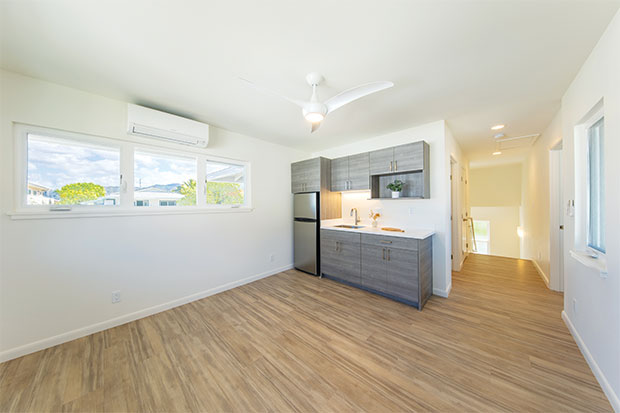The word “home” means different things to different people. As our lifestyles change constantly, so do the activities and tasks we perform in our homes. And for many reasons, it is helpful to have spaces in our homes that can change and evolve, too.
“Truly flexible space fulfills multiple functions and serves more than one purpose,” says Evan Fujimoto, president of Honolulu design/build firm Graham Builders. “Flex spaces help you do more with the space you actually have to work with.”
What’s the best way to approach the design of a flexible home? Fujimoto shares a few tips on how to maximize the space you’ve got, both now and in the near and distant future — and how that can save you and your family tens of thousands of dollars.
MAKE EVERY SPACE DELIGHTFUL
Over the years, buying one home and selling another when your family’s size or needs change can be incredibly expensive. Research shows that it takes about four years to recoup the costs of purchasing a home. And moving can be both expensive and exhausting.
“In the long run, it’s both wiser and cheaper to plan for accommodating your own future needs, and those of your family, when you’re building or renovating,” advises Fujimoto. “If you think of a home as your lifetime home when you’re building it, and design every space to delight your personal taste, you’ll likely stay in it for longer.”
He recommends investing in better, higher-quality fixtures and finishes that suit you, if you plan to stay in your home for decades.
“In a multigenerational home, what you need now may not be what you need years down the line, as things change and people age,” Fujimoto adds. “Try to plan your home or renovation so that you can easily enlarge or change the space later, building upwards or outwards, as need demands.”
Reinforced stairways make it simpler to add a chair lift, and closets that are vertically aligned on the first and second floors make it easier to add elevators. And if you think you might one day add an ohana or guest suite, you might want to plan ahead for the location of a separate entrance, another bathroom and even a wet bar. Plumbing and electrical rough-ins can be configured to make it easier to install new fixtures for future remodeling projects.
If your new or renovated home will include an attic, install insulation with a higher R-value — an indicator of its effectiveness — so that it will stay cool on Oahu’s hotter days, and make sure the design includes ceilings that aren’t uncomfortably low. You might only plan to use it to store Christmas ornaments and the kids’ old toys and clothes, but someday you might want to include it in your family’s active living space.
“Second living rooms are ideal when the main living room becomes overcrowded,” Fujimoto says. “Any unused space can be used for games with the family, a gathering area, a tranquil retreat for meditation.”
Rooms that serve as hobby spaces, workout rooms, and home offices can be furnished with pull-out sofa beds and pull double duty as guest rooms.
“Ultimately, open plans work best,” concludes Fujimoto. “If your home is designed to be flexible, your family won’t feel restricted or cut off from each other. You’ll each have privacy, but you’ll also have a really comfortable and inviting space to entertain, and to be together. Adaptable spaces allow everyone to get what they need.”
A leader in the design and construction of multi-generational homes and aging-in-place design, Graham Builders can help you plan a new home or renovation that will evolve and change with your family’s needs. Its next free “Building Your Home for Life” seminar is scheduled for Jan. 7. Register now online at grahambuilders.com or call 808-593-2808.
GRAHAM BUILDERS
CONTACT 808-593-2808
WEB grahambuilders.com
See more articles from: Graham Builders


